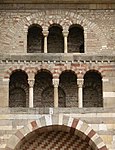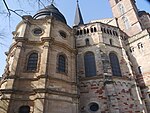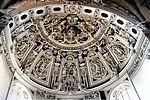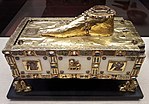
Trier, formerly and traditionally known in English as Trèves and Triers, is a city on the banks of the Moselle in Germany. It lies in a valley between low vine-covered hills of red sandstone in the west of the state of Rhineland-Palatinate, near the border with Luxembourg and within the important Moselle wine region.

Cathedrals, collegiate churches, and monastic churches like those of abbeys and priories, often have certain complex structural forms that are found less often in parish churches. They also tend to display a higher level of contemporary architectural style and the work of accomplished craftsmen, and occupy a status both ecclesiastical and social that an ordinary parish church rarely has. Such churches are generally among the finest buildings locally and a source of regional pride. Many are among the world's most renowned works of architecture. These include St Peter's Basilica, Notre-Dame de Paris, Cologne Cathedral, Salisbury Cathedral, Antwerp Cathedral, Prague Cathedral, Lincoln Cathedral, the Basilica of Saint-Denis, Santa Maria Maggiore, the Basilica of San Vitale, St Mark's Basilica, Westminster Abbey, Saint Basil's Cathedral, Antoni Gaudí's incomplete Sagrada Família and the ancient cathedral of Hagia Sophia in Istanbul, now a mosque.

Aachen Cathedral is a Catholic church in Aachen, Germany and the seat of the Diocese of Aachen.
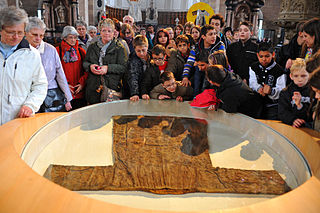
The Seamless Robe of Jesus is the robe said to have been worn by Jesus during or shortly before his crucifixion. Competing traditions claim that the robe has been preserved to the present day. One tradition places it in the Cathedral of Trier, another places it in Argenteuil's Basilique Saint-Denys, and several traditions claim that it is now in various Eastern Orthodox churches, notably Svetitskhoveli Cathedral in Mtskheta, Georgia.
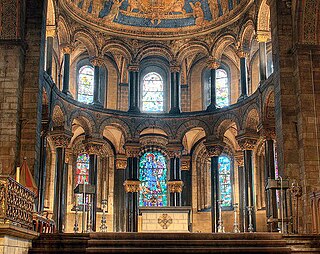
Mosan art is a regional style of art from the valley of the Meuse in present-day Belgium, the Netherlands, and Germany. Although in a broader sense the term applies to art from this region from all periods, it generally refers to Romanesque art, with Mosan Romanesque architecture, stone carving, metalwork, enamelling and manuscript illumination reaching a high level of development during the 11th, 12th and 13th centuries.

Hildesheim Cathedral, officially the Cathedral of the Assumption of Mary or simply St. Mary's Cathedral, is a medieval Roman Catholic cathedral in the city centre of Hildesheim in Lower Saxony, Germany, that serves as the seat of the Diocese of Hildesheim. The cathedral has been on the UNESCO World Cultural Heritage list since 1985, together with the nearby St. Michael's Church because of its unique art and outstanding Romanesque architecture.

The Cathedral of the Savior or La Seo de Zaragoza is a Roman Catholic cathedral in Zaragoza, in Aragon, Spain. It is part of the World Heritage Site Mudéjar Architecture of Aragon.
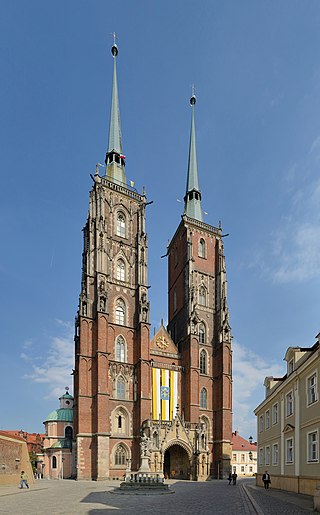
The Cathedral of St. John the Baptist in Wrocław is the seat of the Archdiocese of Wrocław and a landmark of the city of Wrocław in Poland. The cathedral, located in the Cathedral Island, is a Gothic church with Neo-Gothic additions. The current standing cathedral is the fourth church to have been built on the site.

St Peter's Cathedral is a Roman Catholic church and former cathedral in Worms, southern Germany.

Speyer Cathedral, officially the Imperial Cathedral Basilica of the Assumption and St Stephen, in Latin: Domus sanctae Mariae Spirae in Speyer, Germany, is the seat of the Roman Catholic Bishop of Speyer and is suffragan to the Roman Catholic Archdiocese of Bamberg. The cathedral, which is dedicated to St. Mary, patron saint of Speyer and St. Stephen is generally known as the Kaiserdom zu Speyer. Pope Pius XI raised Speyer Cathedral to the rank of a minor basilica of the Roman Catholic Church in 1925.
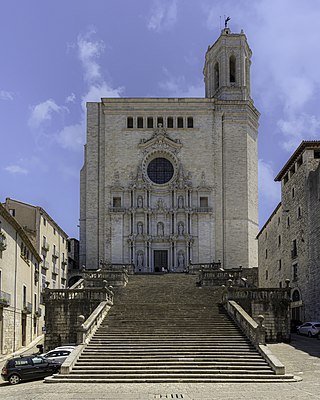
Girona Cathedral, also known as the Cathedral of Saint Mary of Girona, is a Roman Catholic church located in Girona, Catalonia, Spain. It is the seat of the Roman Catholic Diocese of Girona. The cathedral's interior includes the widest Gothic nave in the world, with a width of 23 metres (75 ft), and the second-widest of any church after that of St. Peter's Basilica. Its construction was begun in the 11th century in the Romanesque architectural style, and continued in the 13th century in the Gothic style. Of the original Romanesque edifice only the 12th-century cloister and a bell tower remain. The second bell tower was completed in the 18th century.
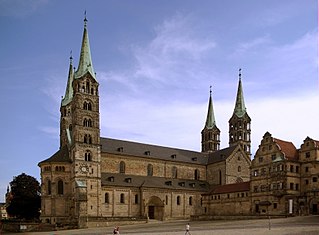
Bamberg Cathedral is a church in Bamberg, Germany, completed in the 13th century. The cathedral is under the administration of the Roman Catholic Church and is the seat of the Archbishop of Bamberg. Since 1993, the cathedral has been part of the UNESCO World Heritage Site "Town of Bamberg".

The Basilica of Saint Servatius is a Roman Catholic church dedicated to Saint Servatius, in the city of Maastricht, the Netherlands. The architecturally hybrid but mainly Romanesque church is situated next to the Gothic church of Saint John, backing onto the town's main square, Vrijthof.

Essen Minster, since 1958 also Essen Cathedral is the seat of the Roman Catholic Bishop of Essen, the "Diocese of the Ruhr", founded in 1958. The church, dedicated to Saints Cosmas and Damian and the Blessed Virgin Mary, stands on the Burgplatz in the centre of the city of Essen, Germany.

Würzburg Cathedral is a Roman Catholic cathedral in Würzburg in Bavaria, Germany, dedicated to Saint Kilian. It is the seat of the Bishop of Würzburg and has served as the burial place for the Prince-Bishops of Würzburg for hundreds of years. With an overall length of 103 metres, it is the fourth largest Romanesque church building in Germany, and a masterpiece of German architecture from the Salian period. Notable later additions include work by Tilman Riemenschneider and Balthasar Neumann. The cathedral was heavily damaged by British bombs in March 1945 but rebuilt post-World War II.

Saint Mary's Cathedral, better known as Lugo Cathedral, is a Roman Catholic church and basilica in Lugo, Galicia, north-western Spain. The cathedral was erected in the early 12th century in a Romanesque style, with Gothic, Baroque and Neoclassicist elements.
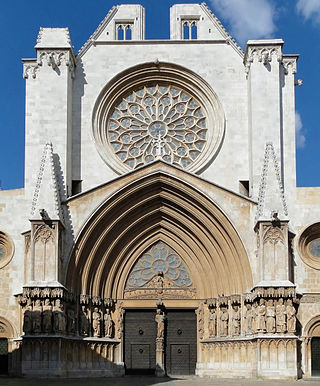
The Primatial Cathedral of Tarragona is a Roman Catholic church in Tarragona, Catalonia, Spain. The edifice is located in a site previously occupied by a Roman temple dating to the time of Tiberius, a Visigothic cathedral, and a Moorish mosque. It was declared a national monument in 1905.
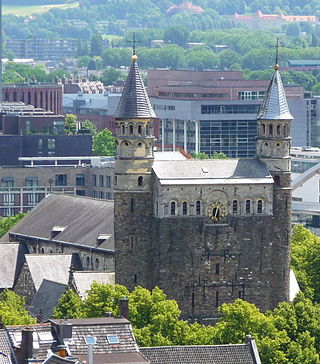
The Basilica of Our Lady is a Romanesque church in the historic center of Maastricht, Netherlands. The church is dedicated to Our Lady of the Assumption and is a Roman Catholic parish church in the Diocese of Roermond. The church is often referred to as the Star of the Sea, after the church's main devotion, Our Lady, Star of the Sea.

St. Patrokli is a Roman Catholic parish and church in Soest, Germany. The church is of great significance in the history of architecture as it is the epitome of Romanesque architecture in Westphalia. As a result, it is known as St.-Patrokli-Dom. It holds relics of its patron saint Patroclus of Troyes from 954. It was the church of the canonical foundation of St. Patroclus, which existed from the 10th century until its abolition in 1812. Since 1823 the church has been the parish church of the St. Patrokli parish in the diocese of Paderborn. In 1859 it was promoted to the rank of provost church.

The Trier Cathedral Treasury is a museum of Christian art and medieval art in Trier, Germany. The museum is owned by the Roman Catholic Diocese of Trier and is located inside the Cathedral of Trier. It contains some of the church's most valuable relics, reliquaries, liturgical vessels, ivories, manuscripts and other artistic objects. The history of the Trier church treasure goes back at least 800 years. In spite of heavy losses during the period of the Coalition Wars, it is one of the richest cathedral treasuries in Germany. With the cathedral it forms part of a UNESCO World Heritage Site.




